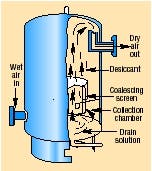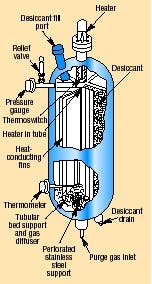Figure 1. Deliquescent chemical dryer takes moisture-laden air into collection chamber and passes it though support screens into desiccant chamber where part of water vapor is removed.
Figure 2. Cutaway view of one tower of heated regenerative desiccant dryer shows electrically heated fins used to dry saturated chemical desiccant.
When pneumatic components wear or become corroded as a result of moisture, they consume more compressed air — and lose energy efficiency. When this wear or corrosion becomes great enough, components must be repaired or replaced — increasing operating expense.
The cost of replacement parts, labor, standby inventory, and downtime can have a devastating effect on the plant's bottom line. Eliminating even one of them by drying a system's compressed air will offset the cost of installing and operating the equipment to do the job.
Types of dryers
Dryers remove water vapor from the air, which lowers its dew point — the temperature to which air can be cooled before water vapor begins to condense. In broadest terms, there are four basic types of industrial compressed air dryers: deliquescent, regenerative desiccant, refrigeration, and membrane.
Deliquescent dryers contain a chemical desiccant which absorbs moisture contained in the air, whether the moisture has already condensed or is still a vapor, Figure 1. The desiccant is consumed in the water-removal process and must be replenished periodically. The solution that must be drained from these dryers contains both liquid water and the deliquescent chemical, so disposal may be a problem. Local environmental regulations should be checked before disposal of this solution.
Deliquescent dryers reduce the dew point of the air 15° to 25° F below the inlet air temperature. If the incoming air has a dew point of 90° F, it will leave a deliquescent dryer with a dew point of about 65° F. Depending on operating conditions, some deliquescent dryers can produce dew points as low as 40° F; new deliquescent chemicals may produce even lower dew points.
Two important points: desiccant level should not be allowed to fall below that recommended by the dryer manufacturer, and inlet temperature should be limited to 100° F or less to prevent excessive desiccant consumption.
Regenerative desiccant dryers remove water from air by adsorbing it on the surface of a microscopically porous desiccant, usually silica gel, activated alumina, or molecular sieve. The desiccant does not react chemically with the water, so it does not need to be replenished. However, it must be dried, or regenerated, periodically.
Heatless regenerative dryers use two identical chambers filled with desiccant. As wet air moves up through one chamber, a portion of the dry discharged air is diverted through the second chamber at close to atmospheric pressure, reactivating its desiccant. The moisture-laden purge air is vented to atmosphere. Some time later, air flow through the chambers is reversed. Standard industry dewpoint ratings for these dryers is 40° F at pressure. By adjusting the flow rates and volume of purge air, 100° F pressure dewpoints can be achieved. These dryers, as with all desiccant dryers, should be supplied with oil-free air. Oil will greatly reduce the life expectancy of the desiccant.
Heat regenerative dryers also use two identical chambers, Figure 2. In this type, however, air flows through one chamber until its desiccant has adsorbed all the moisture it can hold. Then air flow is diverted to the second chamber. Internal heating elements or an external source of heat (steam or electricity) then dries the saturated desiccant in the first chamber. Because desiccant's adsorption capacity decreases as temperature increases, the dried desiccant bed must be cooled from the temperature it reaches during regeneration before it can be used again. The regeneration cycle in these dryers usually lasts several hours — 75% heating and 25% cooling. Regenerative desiccant dryers can produce pressure dew points as low as 100° F. The type of desiccant used has a definite effect on the final dew point.
Refrigeration dryers condense moisture from compressed air by cooling the air in heat exchangers chilled by refrigerants. These dryers produce dew points in a range from 35° to 50° F at system operating pressure.
Most 20-scfm and larger refrigeration dryers reheat the cooled air after it has been dried, usually by routing it through heat exchangers in contact with the hot incoming air. Reheating the cooled air prevents condensation from forming on the exterior of air lines downstream from the dryer and also precools incoming air.
Standard refrigerating dryers should not be used where ambient temperature can drop below 40° F because lower temperature can freeze condensate. This will block air passages and could damage the dryer's evaporator. Dryers may be equipped with heat tracing packages for operating in ambient temperatures as low as 50° F.
Refrigeration dryers should not be operated in conditions where the incoming air and ambient air heat load is 15 to 20% of the rating — a 100-scfm rated dryer (100° F inlet and ambient) can freeze up if operated at 20 scfm and 40° F.
Refrigeration dryer types
Refrigeration dryers can be further classified into three types:
Tube-in-tube refrigeration dryers operate by cooling a mass of aluminum granules or bronze ribbon that in turn cools the compressed air. As the tube-to-tube refrigeration dryer cycles, a thermometer in the granule mass senses its temperature. As the temperature rises, a switch turns on the refrigeration unit. When the temperature drops to a cut-off point, refrigeration stops. These dryers are designed to produce dew points of 35° or 50° F.
Water-chiller refrigeration dryers use a mass of water for cooling. An extra heat exchanger is needed to maintain chilled water flow through the condenser, as well as a water pump. Dew points can be between 40° and 50° F. Waterchiller dryers cycle as they operate.
Direct-expansion refrigeration dryers use a refrigerant-to-air cooling process to produce pressure dew points of 35° F below standard operating conditions (100° F temperature at compressor inlet, 100 psig, 100° F ambient — from the NFPA standard). No recovery period is necessary, so direct-expansion refrigeration dryers run continuously. The cost difference between cycling and continuous operation is difficult to calculate. The difference in electrical power consumption between cycling and non-cycling refrigerated dryers is outweighed by the value of continuous operation of the plant's pneumatic equipment.
Membrane-type dryers
Membrane-type dryers are gasseparation devices. They consist of miniature membrane tubes made of plastic materials compounded to allow water vapor to pass through when there is a vapor pressure differential. They work as your lungs do, venting water vapor each time you exhale.
Typically, this membrane material is formed into bundles of thousands of individual fibers from one end of the dryer to the other. Water vapor escapes through the walls of the fiber to a sweep chamber from where it is continually vented to atmosphere as a gas. A fraction of the dried air is routed through the sweep chamber to continuously purge and exhaust moisture vapor.
Industrial-grade membranes can be used for years to dry air continuously. They respond spontaneously to any change in inlet conditions. They perform at temperatures between 40° and 150° F (ambient or inlet), and handle pressures from about 60 to 300 psig. They will deliver a consistent outlet dew-point reduction anywhere between these extremes. The inlet flow rate and pressure determine the outlet dew point suppression — a consistent level of drying protection is delivered, which follows the rise or fall of the inlet dew point temperature, and can easily be sized to follow the ISA recommended 20° F pressure dew point suppression below ambient. Outlet pressure dew points can also be selected as low as 50° F. Flow capacities are relatively low, but modules can be installed in parallel for higher flows.
Prefilters mounted immediately upstream from the membrane dryer keep out liquids and solids to allow an almost unlimited service life. Because water vapor passes right through the membrane material, membranes do not become saturated and never need to be regenerated. Membranes have no moving parts to wear out. They are non-electric and suitable for most hazardous locations. They make no noise and, they can be mounted in any orientation. They have almost no pressurized volume, so most pressure code restrictions do not apply.
Note: membrane gas separators will remove other gases too. Some membrane-type compressed air dryers can reduce outlet oxygen concentrations (or not permeate oxygen at all).
Installation and maintenance
Location can affect how well an air dryer performs. The site for an air-cooled dryer should be well ventilated, so heat can be carried away, and readily accessible to aid maintenance. The maximum ambient temperature for a refrigerated dryer is about 100° to 120° F. Higher temperatures prevent the dryer from exchanging heat with its surroundings and keep it from operating properly. Dryers with water-cooled condensers can tolerate higher ambient temperature because they transfer heat to the cooling water instead of to the surrounding environment. Refrigerant dryers, whether air-or watercooled, should not be exposed to ambient temperature below 32° F unless optional low-ambient-temperature controls are installed.
If a deliquescent dryer is used in a central compressed-air system, bypass piping should be installed around the dryer to maintain air supply whenever the dryer is taken off line to add desiccant. There should also be no set of operating conditions that permit system pressure to drop low enough to allow high, turbulent air flow through the dryer that might carry chemicals into system air lines. It is important to shut off the water in water-cooled aftercoolers when the air system is shut down. A leak in the aftercooler could flood the deliquescent dryer and fill downstream piping with desiccant, making all pneumatic components inoperable.
Refrigeration and deliquescent dryers should be drained regularly, depending on the volume of liquid accumulated. Most refrigeration dryers have automatic drains, at least as an option.
It should be noted that dryers remove water vapor, while filters remove liquid water. A good drying system always has a filter with an automatic drain installed upstream from the air dryer. Air dryers of all types are not stand-alone components. The cost of adequate prefilters, both particulate and oil coalescing, is a wise investment to protect the more expensive dryers. Postfilters are necessary for several reasons. For refrigerated dryers, a coalescing filter can catch any oil from a refrigerant leak. For deliquescent dryers, a particulate filter downstream will catch any carryover of the corrosive desiccant. For regenerative dryers, a 0.5-µm postfilter is necessary to catch desiccant dust, which is common to all adsorptive desiccants.
For more information on dryers, including details on the importance of dew point and evaluating flow capacity, please visit www.hydraulicspneumatics.com and click on Fluid Power Handbook & Directory.




